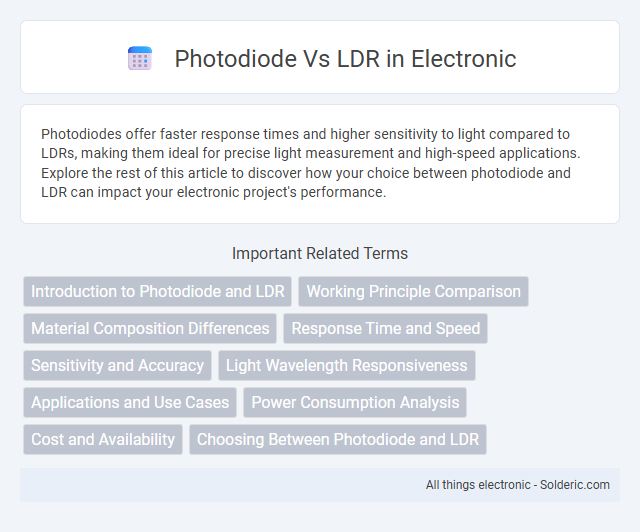Photodiodes offer faster response times and higher sensitivity to light compared to LDRs, making them ideal for precise light measurement and high-speed applications. Explore the rest of this article to discover how your choice between photodiode and LDR can impact your electronic project's performance.
Comparison Table
| Feature | Photodiode | LDR (Light Dependent Resistor) |
|---|---|---|
| Principle | Semiconductor pn junction | Resistance changes with light intensity |
| Response Time | Fast (nanoseconds to microseconds) | Slow (milliseconds to seconds) |
| Sensitivity | High sensitivity to light | Moderate sensitivity |
| Spectral Range | Wide wavelength range (UV to IR) | Visible light range |
| Output | Current proportional to light intensity | Variable resistance |
| Linearity | Good linearity | Non-linear |
| Applications | Optical communication, light meters, photometry | Ambient light sensing, night lights, alarm systems |
| Cost | Higher | Lower |
| Durability | Robust, less affected by ambient conditions | Less durable, sensitive to temperature & humidity |
Introduction to Photodiode and LDR
Photodiodes are semiconductor devices that convert light into electrical current, offering fast response times and high sensitivity ideal for precise light detection. Light Dependent Resistors (LDRs), also known as photoresistors, change their resistance based on ambient light intensity, providing a cost-effective solution for light sensing with slower response speeds. Understanding the differences in material properties and response behaviors between photodiodes and LDRs helps you select the optimal sensor for your specific light detection applications.
Working Principle Comparison
Photodiodes operate based on the photoelectric effect, where incident photons generate electron-hole pairs, causing a current proportional to light intensity, enabling fast and linear response times. Light Dependent Resistors (LDRs) function by changing their resistance in response to light-induced variations in semiconductor material conductivity, resulting in slower response and non-linear characteristics. The inherent difference in photoconductive vs. photovoltaic mechanisms distinguishes their suitability for applications requiring precise light measurement versus simple light detection.
Material Composition Differences
Photodiodes are primarily composed of semiconductor materials such as silicon or gallium arsenide, enabling fast and precise light detection due to their p-n junction structure. LDRs (Light Dependent Resistors), made from cadmium sulfide (CdS) or cadmium selenide (CdSe), rely on photoconductive properties that cause their resistance to vary with light intensity. Understanding these material composition differences helps You choose the right sensor for applications requiring either rapid response or cost-effective ambient light measurement.
Response Time and Speed
Photodiodes exhibit significantly faster response times and higher speed compared to LDRs, making them ideal for applications requiring rapid light detection and precise timing. LDRs, or Light Dependent Resistors, have slower reaction times due to their resistive nature, often measured in milliseconds, whereas photodiodes respond in nanoseconds to microseconds. Choosing a photodiode ensures your system benefits from superior speed and swift light signal processing.
Sensitivity and Accuracy
Photodiodes offer higher sensitivity and faster response times compared to LDRs, making them ideal for precise light measurement applications. LDRs have slower response and lower accuracy due to their resistance-based operation, which is influenced by temperature changes and aging. Your choice depends on whether accurate, rapid detection is critical, favoring photodiodes over LDRs for enhanced sensitivity and reliability.
Light Wavelength Responsiveness
Photodiodes exhibit high responsiveness to specific wavelengths of light, typically in the near-infrared to visible spectrum, enabling precise detection in applications like fiber optic communication and medical devices. LDRs (Light Dependent Resistors), made from cadmium sulfide, have broader wavelength sensitivity, primarily in the visible range but with slower response times and less accuracy. The choice between photodiodes and LDRs depends on the required spectral sensitivity and response speed for accurate light measurement.
Applications and Use Cases
Photodiodes are widely used in high-speed optical communication systems, barcode scanners, and medical devices due to their fast response time and sensitivity to specific light wavelengths. LDRs (Light Dependent Resistors) are ideal for ambient light sensing applications such as automatic street lighting, alarm systems, and camera exposure control, where slower response times are acceptable. Your choice depends on the required response speed and precision in detecting light intensity variations.
Power Consumption Analysis
Photodiodes exhibit significantly lower power consumption compared to Light Dependent Resistors (LDRs) due to their semiconductor-based operation and faster response times. LDRs rely on varying resistance to light intensity, which often requires additional circuitry and continuous power supply, increasing overall energy usage. Photodiode sensors operate efficiently with minimal bias current, making them ideal for battery-powered and low-energy applications where power efficiency is critical.
Cost and Availability
Photodiodes generally have a higher upfront cost than LDRs due to their semiconductor materials and manufacturing complexity, but they offer greater precision and faster response times. LDRs are widely available and inexpensive, commonly used in consumer electronics for basic light sensing where cost sensitivity is crucial. Bulk purchasing reduces costs for both components, but photodiodes dominate in applications requiring reliability and durability.
Choosing Between Photodiode and LDR
Choosing between a photodiode and an LDR depends on your specific application requirements such as response time, sensitivity, and light conditions. Photodiodes offer faster response times and higher accuracy in low-light environments, making them ideal for precise measurement applications. LDRs are cost-effective and simpler to implement, suitable for general light detection where speed and precision are less critical.
Photodiode vs LDR Infographic

 solderic.com
solderic.com